Introduction
Few things compare to the joy of biting into a warm, flaky pastry fresh out of the oven. Among the world’s beloved pastries, Gipfeli recipe holds a special place in Swiss culinary tradition. With their delicate layers, golden crust, and irresistible buttery aroma, these crescent-shaped delights have become a staple in Swiss bakeries and breakfast tables. But what makes Gipfeli stand out from their French counterparts, such as the medialunas of Argentina? How can you recreate this Swiss favorite in your own kitchen?
Brief Overview of Gipfeli and Its Swiss Origins
Gipfeli, often referred to as Swiss croissants, have deep roots in Switzerland’s bakery culture. The name “Gipfeli” comes from the German word Gipfel, meaning “summit” or “peak,” which perfectly describes their characteristic crescent shape. Unlike traditional French croissants, Swiss Gipfeli are typically denser and more compact, offering a heartier bite while still retaining their signature flakiness.
Historically, Gipfeli became popular in Switzerland as a morning staple, enjoyed alongside coffee or hot chocolate. Their origins are tied to the Austrian Kipferl, a pastry dating back to at least the 13th century. Over time, Swiss bakers refined the recipe, balancing butter content, dough texture, and preparation techniques to create the version enjoyed today.
Why You’ll Love Gipfeli Recipe
The Gipfeli recipe is a delightful pastry that combines rich, buttery layers with endless possibilities for flavor variations, making it a versatile treat for any occasion. With its crispy exterior and soft, tender interior, it’s reminiscent of croissant rolls, offering the perfect balance of texture and taste. Whether you prefer it sweet with jam or honey, or savory with cheese and cold cuts, this pastry can easily adapt to your cravings. Not only is it a joy to bake, but the process itself—rolling the dough and watching it rise—provides a sense of accomplishment and satisfaction. Whether shared with loved ones or enjoyed alone, Gipfeli brings warmth, comfort, and a touch of elegance to any meal or celebration.
Comparison to French Croissants and Unique Characteristics
At first glance, Gipfeli Recipe and French croissants seem almost interchangeable, but subtle differences set them apart.
- Texture & Density: While French croissants are meticulously laminated to create airy, honeycomb-like interiors, Gipfeli are typically a bit more compact. This slight density gives them a more substantial mouthfeel, making them particularly satisfying for breakfast or a quick snack.
- Butter Content: French croissants are renowned for their rich, buttery profile, achieved by using high-fat European butter and extensive rolling dough techniques. Gipfeli, however, contain less butter, giving them a lighter taste while still retaining a pleasant flakiness. Some variations even use a touch of milk in the dough to create a softer crumb.
- Sweet vs. Savory Variations: While French croissants are often plain or filled with chocolate, almond paste, or ham and cheese, Gipfeli come in a wide array of textures and flavors. Many Swiss bakeries offer Zöpfli Gipfeli, which have a brioche-like texture, or Ruchmehl Gipfeli, incorporating Swiss whole-grain flour for a more rustic taste.
- Baking Process & Ingredients: The French approach to croissant-making involves precise lamination techniques with multiple folds and rest periods to achieve perfect layers, making a layers croissant that’s a delicate work of art. In contrast, Gipfeli recipe tend to be more forgiving, making them more accessible for home bakers. Additionally, Swiss versions sometimes use a small amount of yeast, creating a unique texture difference and lighter rise.
- Crispness vs. Softness: A classic French croissant boasts an ultra-crisp exterior that shatters with every bite. On the other hand, Gipfeli recipe feature a slightly softer crust, which makes them easier to bite into without excessive crumbling. This quality is particularly appealing for those who prefer a more balanced contrast between crust and interior.
Ingredients for Gipfeli recipe

To create the perfect Gipfeli recipe, high-quality ingredients are key. Here’s what you’ll need:
1. All-Purpose Flour – 500g
The backbone of any great pastry, all-purpose flour provides structure while maintaining the delicate crumb that makes Gipfeli so irresistible. Opt for a high-protein flour if you want a slightly chewier texture, but standard all-purpose flour works just fine.
2. Warm Milk – 250ml
Milk adds tenderness and a slight richness to the dough. The warmth of the milk is crucial, as it activates the yeast, allowing the dough to rise properly. Be careful not to overheat it—lukewarm is ideal (around 37°C or 98°F).
3. Sugar – 50g
A touch of sugar lends a gentle sweetness to the dough and aids in yeast fermentation. While Gipfeli recipe are not as sweet as traditional croissants, this subtle addition enhances the overall depth of flavor.
4. Active Dry Yeast – 1 Packet (About 7g)
Yeast is the driving force behind the dough’s rise, creating a light, airy texture. Ensure that the yeast is fresh and active; expired or inactive yeast will result in dense, underwhelming pastries.
5. Salt – 1 Tsp
A crucial ingredient, salt balances sweetness and enhances the flavor profile of the Gipfeli recipe. It also strengthens the gluten structure, contributing to a well-formed dough.
6. Unsalted Butter – 250g (Cold and Cut into Small Pieces)
Butter is the soul of Gipfeli. Unlike croissants, where butter is laminated in thin layers, Gipfeli dough incorporates butter directly, resulting in a slightly different texture—flaky but with a firmer bite. Use high-quality, cold unsalted butter to achieve that signature buttery richness.
7. Beaten Egg – 1
A beaten egg serves as the final touch, giving the Gipfeli their characteristic golden, glossy finish. When brushed onto the pastries before baking, it creates an appealing sheen and enhances the crust’s crispiness.
How to Make Gipfeli Recipe
Few things can rival the joy of biting into a freshly baked Gipfeli—a golden, flaky, and buttery pastry that melts in your mouth. While it shares similarities with the French croissant, Gipfeli recipe has a slightly denser crumb, making it a delightful companion to morning coffee or an indulgent afternoon treat.
Creating these pastries from scratch requires patience and precision, but the reward is well worth the effort. Follow this step-by-step guide to achieve bakery-quality Gipfeli Recipe right in your own kitchen.
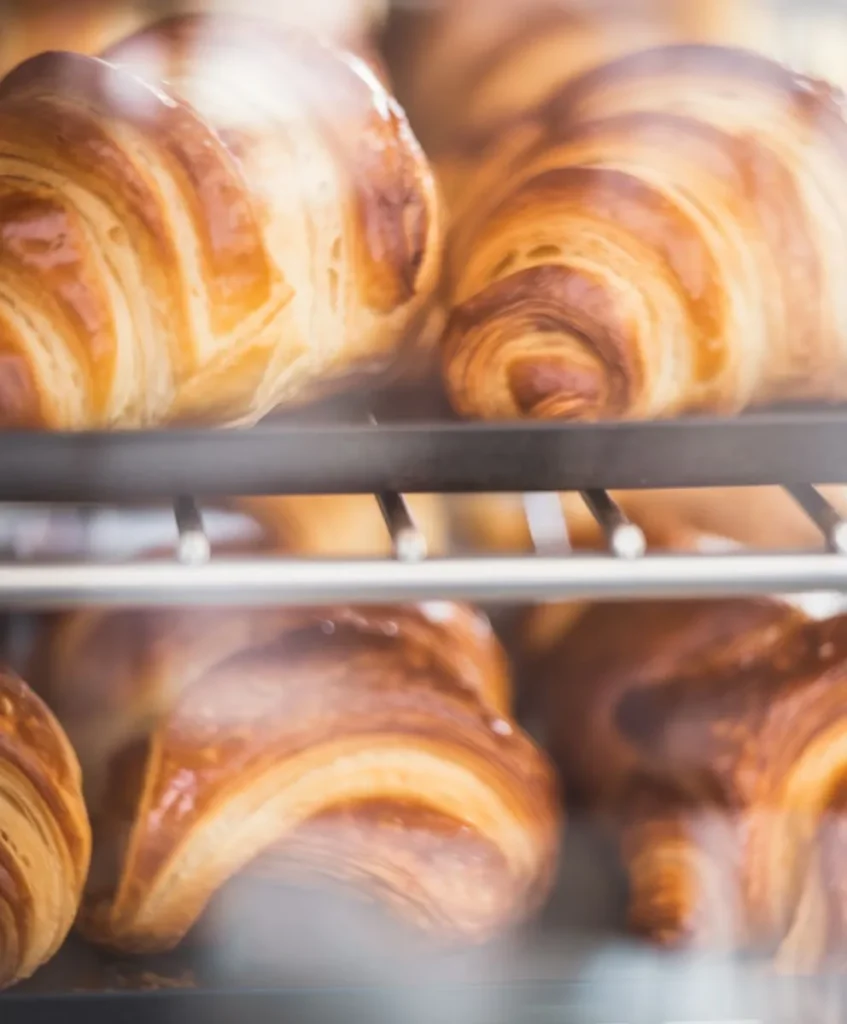
Step 1: Activate the Yeast
In a small bowl, combine warm milk and active dry yeast. Give it a gentle stir and let it rest for about 5 minutes. During this time, the yeast will begin to bloom, forming a frothy layer on the surface. This is a sign that the yeast is active and ready to work its magic in the dough.
Step 2: Prepare the Dry Ingredients
In a large mixing bowl, whisk together all-purpose flour, sugar, and salt. These ingredients form the base of the dough, providing structure and a balanced flavor. Create a well in the center of the mixture by pushing the flour outward—this will make it easier to incorporate the wet ingredients later on.
Step 3: Combine Wet and Dry Ingredients
Carefully pour the frothy yeast-milk mixture into the well you created. Using a wooden spoon or your hands, mix everything together until it forms a cohesive dough. At this stage, the dough may feel sticky and uneven, but don’t worry—it will develop a smooth texture with kneading.
Step 4: Knead the Dough
Transfer the dough onto a lightly floured surface. Knead it vigorously for about 10 minutes, using the heel of your hand to stretch and fold it. This process develops gluten, which is essential for achieving the slightly chewy yet airy texture characteristic of Gipfeli. The dough is ready when it feels smooth and elastic to the touch.
Step 5: First Rise
Place the kneaded dough into a greased bowl, ensuring it is lightly coated with oil to prevent drying out. Cover the bowl with a clean kitchen towel and let it rest in a warm, draft-free spot for about 1 hour, or until it doubles in size. The fermentation process allows the yeast to create air pockets, which will contribute to the pastry’s lightness.
Step 6: Roll Out the Dough
Once the dough has risen, transfer it to a floured work surface and roll it out into a large rectangle. Try to keep the edges even to ensure uniformity in the lamination process.
Step 7: Add the Butter
Distribute small, evenly spaced pieces of cold butter over one half of the dough. This step is crucial—cold butter ensures that distinct layers form within the pastry rather than blending into the dough. Fold the other half of the dough over the butter and press the edges to seal.
Step 8: Begin Laminating the Dough
With a rolling pin, gently roll out the dough into a large rectangle. Next, fold it into thirds, like a letter, trapping the butter inside. This layering process creates the signature flaky texture of Gipfeli. Repeat the rolling and folding process two more times to build up distinct buttery layers.
Step 9: Chill the Dough
Wrap the dough in plastic wrap and place it in the refrigerator for at least 1 hour. Chilling is essential, as it allows the butter to firm up, preventing it from melting into the dough during baking.
Step 10: Shape the Gipfeli Recipe
After the dough has chilled, roll it out one final time into a large rectangle. With a sharp knife or pastry cutter, slice the dough into triangular pieces. The base of each triangle should be wider than the tip, allowing for an even roll.
Step 11: Roll into Crescents
Starting from the wide base, gently roll each triangle toward the tip, forming a crescent shape. Be careful not to press too hard, as this could disrupt the delicate layers you’ve worked so hard to create. Arrange the shaped Gipfeli on a baking sheet lined with parchment paper, leaving enough space for them to expand.
Step 12: Final Proof and Egg Wash
Cover the Gipfeli with a damp kitchen towel and let them proof for another 30 minutes. Meanwhile, preheat your oven to 200°C (400°F). Once proofed, brush the Gipfeli with a beaten egg using a pastry brush—this gives them a golden, glossy finish when baked.
Step 13: Bake to Perfection
Place the Gipfeli in the oven and bake for 15-20 minutes, or until they turn a deep golden brown and puff up beautifully. The irresistible aroma of butter and freshly baked pastry will fill your kitchen.
If you want to elevate your Gipfeli recipe, consider adding a filling. A luscious yuzu curd brings a citrusy zing, while strawberry jam adds a burst of sweetness. Slice open your Gipfeli and generously fill them with your favorite spread for an extra indulgent treat.
Essential Kitchen Equipment for the Perfect Gipfeli Recipe
Making Gipfeli recipe requires precision, patience, and the right tools. The proper equipment ensures your pastries turn out light, flaky, and golden every time. Here’s what you need:
- Mixing Bowls: A set of stainless steel, glass, or ceramic bowls helps with mixing, kneading, and proofing. Opt for non-slip bases for added stability.
- Measuring Cups and Spoons: Precision is key. Use dry measuring cups for flour and sugar, liquid cups for milk and butter, and measuring spoons for salt and yeast.
- Rolling Pin: A wooden or French-style rolling pin ensures even dough thickness, crucial for creating delicate, buttery layers.
- Baking Sheet: A heavy-gauge aluminum or stainless steel baking sheet distributes heat evenly, preventing burnt edges and undercooked centers.
- Parchment Paper: Prevents sticking, ensures even baking, and simplifies cleanup. Silicone baking mats offer a reusable alternative.
- Pastry Brush: Essential for applying egg wash for a golden, glossy finish. Choose natural bristle for precision or silicone for durability.
- Plastic Wrap: Keeps dough fresh and prevents drying during proofing. Ideal for wrapping laminated dough to maintain its structure.
- Damp Cloth: Aids in proofing, covering the dough to retain moisture. Use lint-free cotton or linen to avoid residue on your pastries.
Helpful Tips for Perfect Gipfeli Recipe
Achieving golden, flaky Gipfeli requires precision, patience, and a few expert techniques. These essential tips will elevate your Gipfeli recipe to bakery-level perfection.
Keep Butter Cold: Cold butter is the secret to achieving those crisp, airy layers. Keep it in the fridge until needed to prevent premature melting, which can ruin the delicate lamination process.
Use Warm, Not Hot, Milk: Proper yeast activation is crucial. Ensure your milk is warm (35-40°C/95-105°F)—too hot will kill the yeast, while too cold will slow fermentation, affecting the dough’s rise.
Flour the Surface Lightly: A dusting of flour prevents sticking, but excess can dry out the dough. Balance is key for a smooth rolling process in your Gipfeli recipe.
Roll Gently and Evenly: Apply consistent, light pressure when rolling. If the dough resists, allow it to rest before continuing to avoid tearing.
Shape the Crescent Correctly: For a flawless crescent, roll each triangle from the wide end to the tip with a delicate touch, preserving the intricate layers in your Gipfeli recipe
What to Serve with Gipfeli Recipe?
A fresh, buttery Gipfeli Recipe is a delight on its own, but pairing it with the right accompaniments elevates the experience. Whether you prefer a simple breakfast, a balanced meal, or a sweet indulgence, there are endless ways to enjoy this Swiss classic.
Classic Breakfast Pairings
Milk or Fresh Orange Juice
For a light yet satisfying breakfast, enjoy your Gipfeli recipe with a glass of warm milk or freshly squeezed orange juice. The richness of the pastry contrasts beautifully with the refreshing citrus notes of the juice, making for a well-balanced start to the day.
Fruit Bowl
For a healthier twist, pair your Gipfeli recipe with a bowl of fresh fruit. Berries, apple slices, or even a handful of grapes add a natural sweetness that complements the pastry’s buttery layers.
Jam or Honey
The most traditional way to enjoy Gipfeli recipe is with jam or honey. A light spread of apricot or raspberry jam enhances its flavor, while a drizzle of honey adds a touch of natural sweetness.
Savory Combinations for a Hearty Meal
Scrambled Eggs and Cheese
For a more substantial breakfast, serve Gipfeli alongside fluffy scrambled eggs and a slice of cheese. The creamy texture of the eggs and the rich, slightly salty cheese contrast beautifully with the crisp pastry. This is a classic European breakfast that provides both comfort and nourishment.
Cold Cuts and Butter
In Swiss cafés, Gipfeli recipe is often paired with cold cuts like ham or smoked salmon, along with a spread of butter. This combination is both elegant and satisfying, making it a great option for a leisurely brunch.
Beverage Pairings
Smoothies
A fruit smoothie pairs wonderfully with Gipfeli recipe, adding a refreshing and nutritious touch. A berry blend or a mango-banana smoothie works particularly well, balancing the pastry’s richness with fruity brightness.
Coffee and Tea with Gipfeli recipe
For the ultimate café-style experience, pair your Gipfeli with a steaming cup of coffee or tea. A strong espresso, cappuccino, or latte enhances its buttery layers, while a fragrant Earl Grey or chamomile tea provides a delicate complement.
Variations on the Classic Gipfeli Recipe
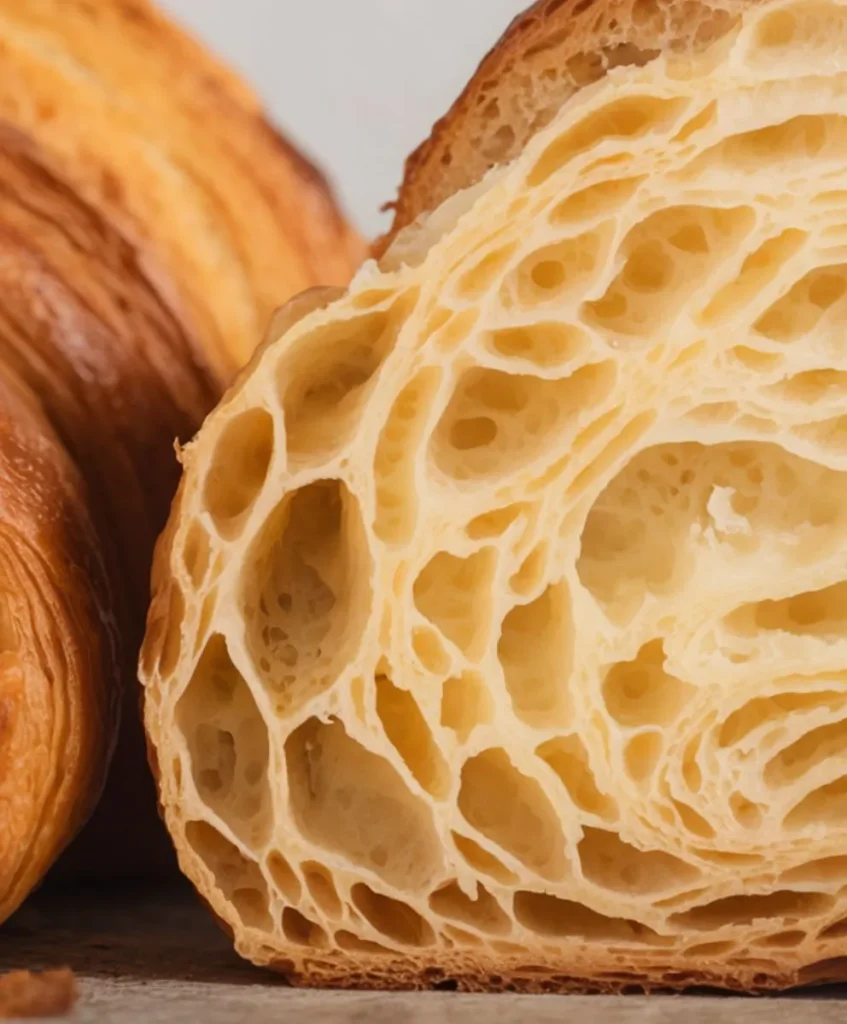
While the classic Gipfeli is a treat on its own, there are many ways to elevate this Swiss pastry with creative twists. Whether you crave sweet indulgence or a savory delight, these variations bring new life to the traditional Gipfeli recipe.
- Filled Gipfeli recipe
Enhance your Gipfeli by adding delicious fillings. For a sweet option, try chocolate ganache, hazelnut spread, or a luscious combination of cream cheese and raspberry jam. If you prefer a savory bite, fillings like ham and cheese or spinach and feta create a rich, satisfying pastry reminiscent of a pressed croissant recipe.
- Fruit-Infused Gipfeli
Balance the buttery richness of croissant rolls with a fruity touch. Fill them with apple cinnamon, apricot preserves, or cherry compote. For a tropical twist, incorporate mango or pineapple, which adds brightness to each flaky bite.
- Spiced Gipfeli recipe
Aromatic spices can transform a classic Gipfeli recipe into something extraordinary. Adding cinnamon, nutmeg, or cardamom to the dough introduces warmth, while a dusting of cinnamon sugar before baking enhances its caramelized crust.
- Vegan Gipfeli recipe
For a dairy-free alternative, substitute butter with vegan margarine or coconut oil, and use plant-based milk for a lighter, yet equally flaky texture. Instead of an egg wash, brush the pastry with almond milk or maple syrup to achieve a golden finish.
- Whole Wheat or Gluten-Free Gipfeli recipe
Switch to whole wheat flour for a nutty depth of flavor or opt for a gluten-free blend to accommodate dietary needs. Despite modifications, the key is rolling dough properly to maintain the distinct layers croissant lovers adore.
- Herb-Infused Gipfeli recipe
For a savory twist, incorporate rosemary, thyme, or basil into the dough. Pair with cheese, olives, or sundried tomatoes for a Mediterranean-inspired pastry.
- Chocolate-Dipped Gipfeli
Once baked, dip the tips of your Gipfeli in melted dark or milk chocolate. For a refined touch, sprinkle with sea salt to balance the sweetness.
- Cinnamon Sugar Gipfeli recipe
For a simple yet irresistible variation, roll the exterior in cinnamon sugar before baking. This enhances the crispness of the crust and pairs beautifully with espresso or hot chocolate.
From sweet to savory, these variations prove that the Gipfeli recipe is endlessly versatile. With careful rolling dough techniques and attention to its layers croissant structure, you can craft a Gipfeli that suits any taste preference. Experiment, enjoy, and bring your favorite flavors to this classic Swiss delight!
Serving and Storage Tips for Gipfeli Recipe
A freshly baked Gipfeli is a golden, buttery marvel that can easily steal the spotlight at any meal. But the real magic happens when you serve it just right and store it properly. Whether you’re enjoying it fresh from the oven or saving some for later, these tips will ensure your Gipfeli recipe delivers delicious results every time.
Serving Tips: Enjoying Gipfeli Recipe at Its Best
1. Serve Warm for Maximum Flavor
Nothing compares to the taste of a warm Gipfeli. When freshly baked, the buttery layers shine, offering a delicate crunch on the outside and a soft, tender center. If you plan to serve your Gipfeli later, refresh it in a preheated oven at 160°C (320°F) for about 5 minutes. This will revive the pastry’s flakiness without compromising its texture. Steer clear of microwaving as it will make the pastry lose its crispness and become chewy instead.
2. Pair with the Right Accompaniments
The versatility of Gipfeli recipe makes it the perfect pastry to pair with a variety of spreads and beverages. Consider these options for an ideal combination:
- Sweet Pairings: Spread your Gipfeli with apricot jam, honey, or Nutella for a luscious treat. Fruit preserves like raspberry or strawberry also work wonderfully to balance the richness.
- Savory Options: For a more savory experience, spread with cream cheese, or add a slice of smoked salmon or a bit of aged cheese.
- Beverage Complements: Pair your pastry with a strong espresso, a frothy cappuccino, or a calming herbal tea to bring out the best flavors in every bite.
For a more luxurious breakfast or brunch, serve alongside fresh fruit, yogurt, and cold cuts, creating a well-rounded meal that satisfies all the senses.
Storage Tips: Keeping Gipfeli Fresh
1. Storing at Room Temperature
If you plan to enjoy your Gipfeli within a day, store it in a paper bag or loosely covered container at room temperature. This helps preserve the crispy layers while keeping it fresh. Avoid sealing the pastry in plastic bags, as they trap moisture, which will make the flaky texture soggy.
2. Refrigeration for Extended Freshness
For longer storage, place your Gipfeli in an airtight container and refrigerate. It can remain fresh for as long as three days. When ready to serve, always reheat it in the oven to restore the pastry’s original crispness.
3. Freezing for Later Use
Freezing your Gipfeli allows you to have fresh, flaky pastries whenever you crave them. To freeze:
- Wrap each Gipfeli tightly in plastic wrap and store them in an airtight container or freezer bag.
- They can be frozen for up to 2 months without losing quality.
- When ready to enjoy, bake from frozen at 180°C (350°F) for 8-10 minutes or until crispy and warm.
4. Storing Unbaked Gipfeli
Want fresh Gipfeli at a moment’s notice? Shape the dough and freeze the croissant rolls before baking. When ready, allow them to thaw in the fridge overnight, let them rise at room temperature for about 30 minutes, and bake as per the usual instructions. This method ensures that your Gipfeli is as fresh as if it were just baked.
PrintGipfeli Recipe
Follow this simple Gipfeli recipe for a delicious taste of Switzerland with every bite of these perfectly baked croissants.
- Prep Time: 1 hour
- Cook Time: 20 minutes
- Total Time: 1 hour 20 minutes
- Yield: 12
- Category: Breakfast
- Method: Baking
- Cuisine: Swiss
Ingredients
All-Purpose Flour (500g): Provides structure while keeping the pastry tender. Sifting ensures a smooth, airy dough.
Warm Milk (250ml): Activates the yeast and adds richness. Keep it at 35-40°C (95-105°F) to avoid killing the yeast.
Sugar (50g): Aids fermentation and adds a subtle sweetness without overpowering the buttery flavor.
Active Dry Yeast (7g): Creates air pockets for a light, airy pastry. Ensure freshness for the best rise.
Salt (1 Tsp): Enhances flavor and strengthens gluten for a well-structured dough.
Cold Unsalted Butter (250g, Small Pieces): Essential for flaky layers. Keep it cold to ensure proper lamination.
Beaten Egg (1): Brushed on top for a glossy, golden finish.
Instructions
In a tiny bowl, mix the yeast with warm milk. Stir lightly and allow it to rest for around 5 minutes. Stir gently and let it sit for about 5 minutes. You should see a frothy layer forming on top of the milk. This is the sign that the yeast is active and ready to work its magic in the dough.

In a spacious mixing bowl, blend together the flour, sugar, and salt. Give them a quick stir to evenly distribute the ingredients. Next, create a well in the center by pushing the flour to the edges. This will allow you to pour in the yeast mixture without splashing it everywhere.
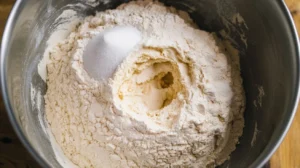
Carefully pour the frothy yeast and milk mixture into the well of dry ingredients. Use a wooden spoon or your hands to mix everything together until it forms a dough. At first, it may seem a little sticky, but don’t worry—this will smooth out during the kneading process.
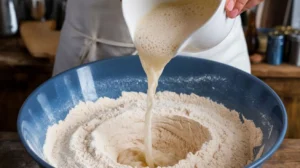
Turn the dough out onto a lightly floured surface and knead it for about 10 minutes. Press down with the heel of your hand and fold the dough over itself, stretching it as you go. This helps develop the gluten, which gives Gipfeli its light, airy texture. After about 10 minutes, the dough should feel smooth and elastic.
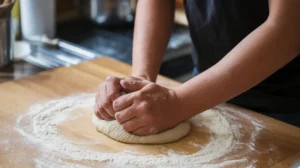
Place the kneaded dough into a greased bowl. Cover it with a clean cloth and leave it in a warm, draft-free spot for about 1 hour. The dough should double in size during this time, as the yeast works its magic, creating air pockets.
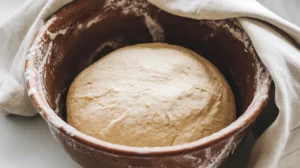
After the dough has doubled in size, move it onto a surface dusted with flour. Roll it out into a large rectangle, making sure to keep the edges even. This will make the lamination process easier and more uniform.
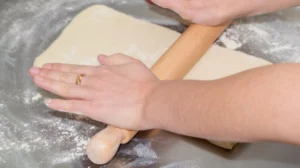
Take small, cold pieces of butter and distribute them evenly over one half of the dough. The butter must be cold to ensure the perfect layers. Once the butter is evenly spread, fold the other half of the dough over it and press down on the edges to seal the butter inside.
Roll out the dough into a large rectangle again, keeping it as even as possible. Then, fold it into thirds like a letter—this is where the magic of layers begins! Repeat the rolling and folding process two more times to build up the delicate, flaky layers that Gipfeli is known for.
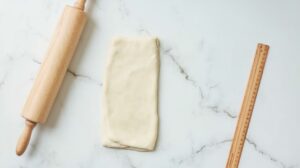
Wrap the dough tightly in plastic wrap and place it in the fridge for at least 1 hour. This chilling step is crucial because it keeps the butter solid, ensuring it remains within the dough during the next rolling steps.
After chilling, roll the dough out one final time into a large rectangle. Use a sharp knife or pastry cutter to slice the dough into triangles. The base of each triangle should be wide enough to easily roll it into a crescent shape.

Starting from the wide base of each triangle, gently roll the dough towards the point. Be sure to roll lightly so the layers don’t get flattened. Place the shaped Gipfeli on a baking sheet lined with parchment paper, leaving space between each one to allow for expansion.
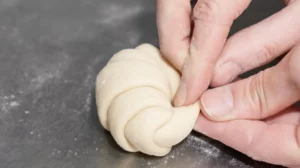
Cover the rolled Gipfeli with a damp kitchen cloth and allow them to rise for another 30 minutes. Meanwhile, preheat your oven to 200°C (400°F). Once the Gipfeli have risen, brush each one lightly with a beaten egg using a pastry brush to give them a golden, glossy finish.
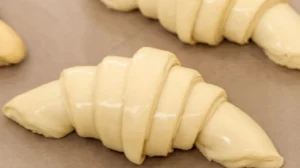
Place the Gipfeli in the oven and bake for 15-20 minutes, or until they turn a rich golden brown and puff up beautifully. The smell of freshly baked pastries will fill your kitchen, and you’ll know they’re ready when they have a crisp, golden exterior.
If you want to take your Gipfeli to the next level, consider adding a filling of your choice. You can stuff them with a tangy yuzu curd or a sweet strawberry jam—whatever suits your taste. Slice open each Gipfeli, add your filling, and enjoy the heavenly layers inside.
Notes
Cold Butter is Essential
Keep the butter cold to ensure flaky layers. Refrigerated butter helps create the delicate, airy texture Gipfeli is known for.
Warm Milk for Yeast Activation
Use warm milk (not hot) to activate the yeast. The ideal temperature is 35°C to 40°C (95°F to 105°F), which helps the dough rise perfectly.
Flour the Surface
Lightly dust your work surface with flour before kneading to prevent sticking. Avoid using too much to keep the dough moist and smooth.
Roll Gently and Evenly
Apply gentle, even pressure when rolling out the dough. Let it rest if it resists, ensuring consistent thickness and layers.
Shape with Care
Roll the dough from the wide end to the pointy tip for a perfect crescent shape. Press the tip lightly to seal, keeping the layers intact.
Nutrition
- Serving Size: 12 Gipfeli
- Calories: 300 kcal
- Sugar: 2g
- Sodium: 304mg
- Fat: 13g
- Saturated Fat: 7g
- Carbohydrates: 16g
- Fiber: 1g
- Protein: 3g
- Cholesterol: 46mg
Frequently Asked Questions
Can I add flavors to the dough?
Yes! You can enhance your Gipfeli recipe by adding flavors like vanilla, cinnamon, cardamom, or citrus zest to the dough. For a savory twist, try incorporating herbs, cheese, or a touch of garlic.
How Can I Make My Gipfeli Extra Flaky?
To achieve ultra-flaky Gipfeli, keep the butter cold and laminate the dough properly by folding and rolling it multiple times. Chill the dough between each fold to maintain distinct layers. Also, avoid over-kneading, as it can toughen the pastry. Baking at the right temperature (200°C/400°F) ensures a crisp, golden texture.
Do I have to use an egg wash?
Using an egg wash is optional. It adds a shiny, golden finish to your Gipfeli, but the pastry will still bake beautifully without it.
What Can I Use Instead of Parchment Paper?
If you don’t have parchment paper, you can use a lightly greased baking sheet or a silicone baking mat. Dusting the tray with a small amount of flour can also help prevent sticking.
Can I Make Gipfeli Without Yeast?
Yes, but the texture will be different. Traditional Gipfeli recipe relies on yeast for a light, airy structure. To make a yeast-free version, use baking powder or baking soda as a leavening agent. However, this will result in a denser, more biscuit-like pastry rather than the classic flaky layers.
Conclusion
The Gipfeli recipe stands out for its perfect balance of buttery layers and flaky texture, reminiscent of a classic medialunas or a well-crafted medialuna from Argentina. This pastry, akin to croissant rolls, achieves its signature lightness through careful rolling dough and layering techniques. Just like a pressed croissant recipe, the dough is folded multiple times, creating delicate layers croissant that bake to golden perfection.
What makes the Gipfeli recipe even more special is its versatility. Whether served plain, with jam, or filled with indulgent treats like chocolate or cheese, it’s a pastry that can cater to any occasion. The technique of layering butter within the dough is key to its satisfying crunch and soft, airy interior. This combination of simplicity and flavor is what makes it so appealing.
For a complete breakfast spread, pair your Gipfeli with a delicious Sheet Pan Eggs recipe. The hearty, fluffy eggs complement the light and flaky nature of the Gipfeli, creating a delightful contrast. Whether you’re a seasoned baker or new to making croissant rolls, the Gipfeli recipe offers a joyful experience. With practice, it transforms into a reliable and beloved treat, perfect for a leisurely breakfast or a cozy afternoon snack.
Leave a comment
Your email address will not be published. Required fields are marked *


